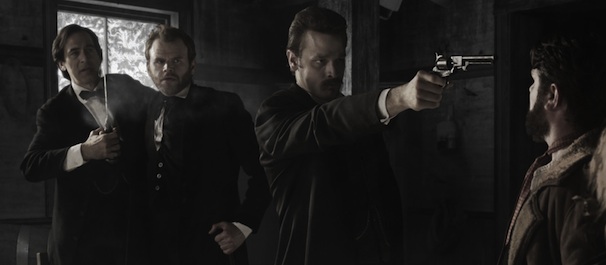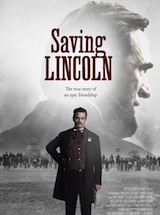
Abraham Lincoln (Tom Amandes), Billy Herndon (Michael Maize) and Ward Hill Lamon (Lea Coco) encounter pro-slavery "border ruffians" in 1856. Saving Lincoln LLC.
Hard on the heels of Steven Spielberg’s justly acclaimed Lincoln, with its Hollywood stars and megabudget, comes Salvador Litvak’s Saving Lincoln, an independent flick with heart and brains.
 Like Spielberg’s movie, Saving Lincoln peels back myths and preconceptions to expose the complex, earthy man, with his love of language, raunchy frontier humor, and delighted willingness to plunge into bruising political scrums. Here we see Lincoln (Tom Amandes) through the sympathetic, watchful eyes of US Marshal Ward Hill Lamon (Lea Coco). Lincoln’s long-time friend turned bodyguard, Lamon is the movie’s narrator. He gives us an intimate view of Honest Abe, from his rise in Illinois politics to just before his assassination, when Lincoln, peacefully fatalistic about dying now that his mission to restore the Union is accomplished, orders Lamon to go Richmond over his furious protests.
Like Spielberg’s movie, Saving Lincoln peels back myths and preconceptions to expose the complex, earthy man, with his love of language, raunchy frontier humor, and delighted willingness to plunge into bruising political scrums. Here we see Lincoln (Tom Amandes) through the sympathetic, watchful eyes of US Marshal Ward Hill Lamon (Lea Coco). Lincoln’s long-time friend turned bodyguard, Lamon is the movie’s narrator. He gives us an intimate view of Honest Abe, from his rise in Illinois politics to just before his assassination, when Lincoln, peacefully fatalistic about dying now that his mission to restore the Union is accomplished, orders Lamon to go Richmond over his furious protests.
The Virginia-born Lamon is an inveterate joker and a banjo picker with a head full of old-timey tunes and a dislike of slavery, all of which immediately endears him to Lincoln. The pair become buddies and law partners. After Lincoln is elected, Lamon, well aware of the rising threats to his friend’s life, becomes the president’s zealous, tireless bodyguard, constantly dealing with his charge’s (often successful) attempts to give him the slip. Lincoln finds Lamon’s entertaining talents an increasingly welcome distraction from heartache, self-recrimination, and despair as his generals dodge directives to attack, the Confederacy keeps winning, the death tolls and bitterness mount, and his son Willie dies.
But Lamon is no mere court jester. The president trusts and confides in him: we see Lincoln’s shrewd, calculating mind and moral sensibilities at work as he discusses the war and tests evolving arguments and positions on slave emancipation, just as he had when the pair rode as partners on the Illinois circuit court’s rounds. Through Lamon, we savor Lincoln’s homespun wit, sly self-possession, periodic rages, bouts of moodiness, depression, and self-deprecation, restless drive, nagging uncertainties, and deep love for his family. It is a thoughtful and moving portrait.
Saving Lincoln is well researched and historically credible. Its narration and dialog come from period sources. Its striking sets are actually vintage photos made three-dimensional by a suite of techniques the director calls CineCollage; the actors were shot on a green-screen stage. The results are generally very effective, though there is one small technical glitch: backdrops can go slightly out-of-sync when the actors are riding in a buggy or train. Well-acted, charming and gripping, Saving Lincoln is a small, shining gem.
—Gene Santoro
[nggallery id=129]




